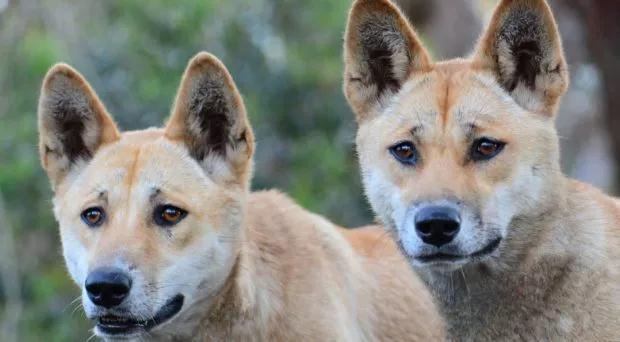|
|
|
|
|
澳洲野狗(dingo)是逃家的流浪者,还是从未服从的入侵者?| BMC Journal |
|
|
论文标题:The Australian dingo: untamed or feral?
期刊:Frontiers in Zoology
作者:J. William O. Ballard and Laura A. B. Wilson
发表时间:2019/02/13
数字识别码:10.1186/s12983-019-0300-6
原文链接:http://t.cn/Eo3igHg
微信链接:https://mp.weixin.qq.com/s/wy63yERsTo1ABzPNXV4A3A
澳洲野狗到底是逃家的野生(feral)动物还是从没有被驯服的(untamed)动物?弄清楚这个问题很重要,因为澳大利亚政府有个政策认为澳洲野狗是一种野生动物,因此允许对它们进行大范围捕杀。Bill Ballard教授和Laura Wilson博士在他们新发表的文章中对这一问题进行了探讨,该文章发表在Frontiers in Zoology 上。

荒漠澳洲野狗Eggie 和Sandy
Barry Eggleton
澳大利亚因许多事情而闻名于世,而“物种灭绝”的阴影不该是这个国家形象中的一部分。
在大约100年前,澳大利亚人造成了袋狼(Thylacine,这是已知现代最大的有袋类食肉动物)的灭绝。在2019年,西澳大利亚政府计划引入一项法案,允许猎杀澳洲野狗,这种该陆地上的顶级捕食动物。由于西澳大利亚覆盖了全澳大利亚大约三分之一的陆地,这一政策上的改变可能会引起会对纯澳洲野狗的屠杀,使得澳大利亚的灭绝物种又添一例。
澳洲野狗被真正驯服过么?
在Frontiers in Zoology 发表的一篇辩论文章中,我们提出了这个简单的问题:“澳洲野狗是否曾经被驯服过?它们现在是以野狗的身份存在,还是从未被真正驯化过?”这个问题的目的是暂停现在的争论,从学术的角度来进行理性的辩论。
弄明白澳洲野狗的起源具有重要的政治和文化意义,因为它们的到来改变了澳大利亚的原著民社会。此外,这个问题也具有重大的生态学意义,因为这一物种的起源能影响我们对澳洲野狗在现存澳大利亚生态系统中的生态学作用的理解。
我们首先追溯到查尔斯·达尔文1868年在The Variation of Animals and Plants under Domestication 一书中的说法。他指出,选择的原则可以简单分为系统选择、无意识选择和自然选择三类。达尔文的“方法选择”一词后来被称为“人工选择”,通过这种“人工选择” ,世界上成千上万种家禽家畜和栽培植物才得以产生和不断繁衍。
根据达尔文的理论,犬科动物类成为被驯养的动物应满足两点:人类无意识地选择其成为驯化动物,并且最终完成了人工选择。所以,根据第一原则,一个被驯化过后又回到野外的动物(我们称之为未被驯化的动物)可以被标记为有无意识选择的特征。与此形成鲜明对比的是,被驯化过又回到野外的野生动物(即feral animals)被假定同时具有无意识选择和人工选择的特征。
这些简单的理论预测为解决争论所需的分析和实验提供了一个模板。

澳洲野狗很有可能在3500-10000年前从东南亚来到澳大利亚的。目前,我们还不清楚这些原始的澳洲野狗是否是被驯养或被驯化的。但我们知道,这些最初到达澳洲的澳洲野狗很可能数量很少,且是乘船到达的。所以澳洲野狗不太可能是在澳大利亚被驯养的。
南澳大利亚存在野狗的最早时间被证实应在3348至3081年前,地点是位于西澳大利亚东南部努拉伯地区罗伊平原的马都拉洞穴。并且它们不曾栖息在塔斯马尼亚岛上,该岛在12000年前由于海平面的变化而从澳大利亚分离出来,这有力的表明澳洲野狗在15000年前还没有到达澳大利亚。
了解原始澳洲野狗是否被驯化的关键是从野生动物中构建一个高质量的、高读长的从头参考基因组。在2017年,我们有幸赢得了Pacific Biosciences 的“世界上最有趣基因组”的评选比赛,并且纯沙漠野狗Sandy(Sandy和她的兄弟姐妹们在4周大的时候被人发现于沙漠中)的全基因组已经发布上网了。

但是有个难题是如何严格检查与特征选择相关的基因组,并通过实验验证野狗是否曾被驯化和驯养过但现在成为了野生的驯养动物。如果真是这样的话,那么要解决这场争论又该弄清楚至少在距今3500年前就融入了澳大利亚的生物群这一事实,是否足以将其确立为一个基石类群。
或者,澳洲野狗可能已经被驯化了,但没有被驯养过。如果是这样,争论的焦点又应是如何制定相应的策略来保护野生犬科动物,并充分明确它们的生态学角色。与此同时,虽然西澳大利亚政府在最后一刻撤销了将澳洲野狗从原生动物名单中除名的决定,但澳洲野狗仍然被政府列为有害动物,并且仍受西澳大利亚农业和牧业地区的“限制”。
摘要:
Background
The Australian dingo continues to cause debate amongst Aboriginal people, pastoralists, scientists and the government in Australia. A lingering controversy is whether the dingo has been tamed and has now reverted to its ancestral wild state or whether its ancestors were domesticated and it now resides on the continent as a feral dog. The goal of this article is to place the discussion onto a theoretical framework, highlight what is currently known about dingo origins and taxonomy and then make a series of experimentally testable organismal, cellular and biochemical predictions that we propose can focus future research.
Discussion
We consider a canid that has been unconsciously selected as a tamed animal and the endpoint of methodical or what we now call artificial selection as a domesticated animal. We consider wild animals that were formerly tamed as untamed and those wild animals that were formerly domesticated as feralized. Untamed canids are predicted to be marked by a signature of unconscious selection whereas feral animals are hypothesized to be marked by signatures of both unconscious and artificial selection. First, we review the movement of dingo ancestors into Australia. We then discuss how differences between taming and domestication may influence the organismal traits of skull morphometrics, brain and size, seasonal breeding, and sociability. Finally, we consider cellular and molecular level traits including hypotheses concerning the phylogenetic position of dingoes, metabolic genes that appear to be under positive selection and the potential for micronutrient compensation by the gut microbiome.
Conclusions
Western Australian Government policy is currently being revised to allow the widespread killing of the Australian dingo. These policies are based on an incomplete understanding of the evolutionary history of the canid and assume the dingo is feralized. However, accumulated evidence does not definitively show that the dingo was ever domesticated and additional focused research is required. We suggest that incorporating ancient DNA data into the debate concerning dingo origins will be pivotal to understanding the evolutionary history of the canid. Further, we advocate that future morphological, behavioural and genetic studies should focus on including genetically pure Alpine and Desert dingoes and not dingo-dog hybrids. Finally, we propose that future studies critically examine genes under selection in the dingo and employ the genome from a wild canid for comparison.
阅读论文全文请访问:
http://t.cn/Eo3igHg
期刊介绍:
Frontiers in Zoology (https://frontiersinzoology.biomedcentral.com/,3.627 - 2-year Impact Factor,3.782 - 5-year Impact Factor) is an open access, peer-reviewed online journal publishing high quality research articles and reviews on all aspects of animal life.
(来源:科学网)
特别声明:本文转载仅仅是出于传播信息的需要,并不意味着代表本网站观点或证实其内容的真实性;如其他媒体、网站或个人从本网站转载使用,须保留本网站注明的“来源”,并自负版权等法律责任;作者如果不希望被转载或者联系转载稿费等事宜,请与我们接洽。